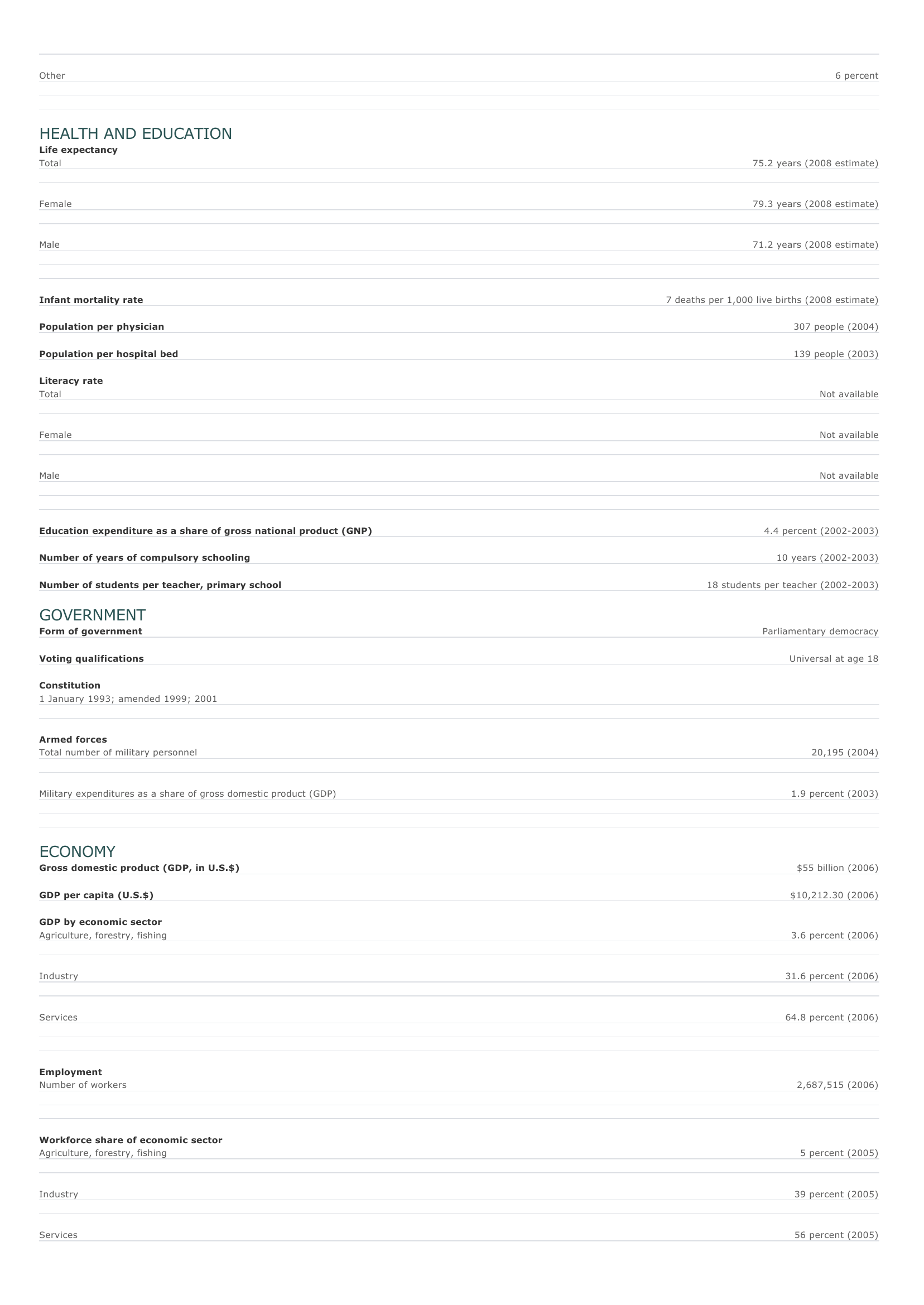Slovakia Facts and Figures. BASIC FACTS Official name Capital Area Slovak Republic Bratislava 49,035 sq km 18,933 sq mi PEOPLE Population 5,455,407 (2008 estimate) Population growth Population growth rate 0.14 percent (2008 estimate) Projected population in 2025 5,458,581 (2025 estimate) Projected population in 2050 4,943,616 (2050 estimate) Population density 112 persons per sq km (2008 estimate) 290 persons per sq mi (2008 estimate) Urban/rural distribution Share urban 58 percent (2005 estimate) Share rural 42 percent (2005 estimate) Largest cities, with population Bratislava 425,000 (2003 estimate) Ko?ice 235,509 (2003 estimate) Pre?ov 92,488 (2003 estimate) Nitra 86,958 (2003 estimate) ?ilina 85,347 (2003 estimate) Ethnic groups Slovak 85.7 percent Hungarian (Magyar) 10.7 percent Roma (Gypsy) 1.5 percent Czech 1.0 percent O ther 1.1 percent Languages Slovak (official), Hungarian, Romani, Ukranian, Czech, German Religious affiliations Roman Catholic 68 percent Protestant 11 percent Atheist Nonreligious 4 percent 11 percent O ther 6 percent HEALTH AND EDUCATION Life expectancy Total 75.2 years (2008 estimate) Female 79.3 years (2008 estimate) Male 71.2 years (2008 estimate) Infant mortality rate 7 deaths per 1,000 live births (2008 estimate) Population per physician 307 people (2004) Population per hospital bed 139 people (2003) Literacy rate Total Not available Female Not available Male Not available Education expenditure as a share of gross national product (GNP) Number of years of compulsory schooling Number of students per teacher, primary school 4.4 percent (2002-2003) 10 years (2002-2003) 18 students per teacher (2002-2003) GOVERNMENT Form of government Parliamentary democracy Voting qualifications Universal at age 18 Constitution 1 January 1993; amended 1999; 2001 Armed forces Total number of military personnel Military expenditures as a share of gross domestic product (GDP) 20,195 (2004) 1.9 percent (2003) ECONOMY Gross domestic product (GDP, in U.S.$) GDP per capita (U.S.$) $55 billion (2006) $10,212.30 (2006) GDP by economic sector Agriculture, forestry, fishing 3.6 percent (2006) I ndustry 31.6 percent (2006) Services 64.8 percent (2006) Employment Number of workers Workforce share of economic sector Agriculture, forestry, fishing 2,687,515 (2006) 5 percent (2005) I ndustry 39 percent (2005) Services 56 percent (2005) Unemployment rate 18.1 percent (2004) National budget (U.S.$) Total revenue $16,800 million (2006) Total expenditure $18,521 million (2006) Monetary unit 1 Slovak koruna (Sk), consisting of 100 halierov Major trade partners for exports Germany, Czech Republic, Italy, Austria, and Poland Major trade partners for imports Germany, Czech Republic, Russia, Italy, and Austria ENERGY, COMMUNICATIONS, AND TRANSPORTATION Electricity production Electricity from thermal sources 31.29 percent (2003 estimate) Electricity from hydroelectric sources 11.60 percent (2003 estimate) Electricity from nuclear sources 57.11 percent (2003 estimate) Electricity from geothermal, solar, and wind sources Number of radios per 1,000 people 0 percent (2003 estimate) 964 (1998 estimate) Number of telephones per 1,000 people 222 (2005) Number of televisions per 1,000 people 407 (2000 estimate) Number of Internet hosts per 10,000 people 212 (2003) Daily newspaper circulation per 1,000 people 131 (2000) Number of motor vehicles per 1,000 people 256 (2004) Paved road as a share of total roads 87 percent (2004) SOURCES Basic Facts and People sections Area data are from the statistical bureaus of individual countries. Population, population growth rate, and population projections are from the United States Census Bureau, International Programs Center, International Data Base (IDB) (www.census.gov). Urban and rural population data are from the Food and Agriculture Organization (FAO) of the United Nations (UN), FAOSTAT database (www.fao.org). Largest cities population data and political divisions data are from the statistical bureaus of individual countries. Ethnic divisions and religion data are largely from the latest Central Intelligence Agency (CIA) World Factbook and from various country censuses and reports. Language data are largely from the Ethnologue, Languages of the World, Summer Institute of Linguistics International (www.sil.org). Health and Education section Life expectancy and infant mortality data are from the United States Census Bureau, International Programs Center, International database (IDB) (www.census.gov). Population per physician and population per hospital bed data are from the World Health Organization (WHO) (www.who.int). Education data are from the United Nations Educational, Scientific and Cultural Organization (UNESCO) database (www.unesco.org). Government section Government, independence, legislature, constitution, highest court, and voting qualifications data are largely from various government Web sites, the latest Europa World Yearbook, and the latest Central Intelligence Agency (CIA) World Factbook. The armed forces data is from Military Balance. Economy section Gross domestic product (GDP), GDP per capita, GDP by economic sectors, employment, and national budget data are from the World Bank database (www.worldbank.org). Monetary unit, agriculture, mining, manufacturing, exports, imports, and major trade partner information is from the statistical bureaus of individual countries, latest Europa World Yearbook, and various United Nations and International Monetary Fund (IMF) publications. Energy, Communication, and Transportation section Electricity information is from the Energy Information Administration (EIA) database (www.eia.doe.gov). Radio, telephone, television, and newspaper information is from the United Nations Educational, Scientific and Cultural Organization (UNESCO) database (www.unesco.org). Internet hosts, motor vehicles, and road data are from the World Bank database (www.worldbank.org). Note Figures may not total 100 percent due to rounding. Microsoft ® Encarta ® 2009. © 1993-2008 Microsoft Corporation. All rights reserved.











